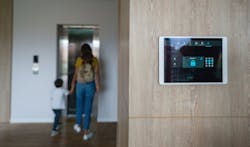The Skinny
-
Centralized, cloud-based platforms integrate access control, video and smart tech, eliminating disconnected systems.
-
Unified security improves resident experience and enables faster, remote incident response.
-
Centralization supports portfolio-wide management, reduces operational costs and enhances property value.
Today’s renters aren't just looking for an apartment; they're choosing a lifestyle hub. As demands for convenience, flexibility, and integrated services grow, the formula for tenant retention is being rewritten in real-time. For multifamily owners, this presents a critical challenge: how to evolve their properties to deliver the modern experience that keeps units filled and profitable without any gaps in security.
The changing nature of multifamily
Multifamily dwellings are no longer just a place to live. Driven by trends like remote work and retail delivery, these buildings must now also function as co-working spaces, package hubs, and recreation center. Nearly half (48%) of renters in 2024 expressed interest in on-site shared workspaces, up from 35% just two years prior. If this trend continues, a majority of renters will want these kinds of amenities in their buildings. Others are looking for the perks of on-demand gym-facilities, on-site laundry, community spaces, gardens.
Tenants are willing to pay a premium for these conveniences. For example, research has found that tenants are willing to pay an average of around $36 extra per month for an on-site co-working space in their community. On top of that, 71% of renters want better security. Across a multifamily portfolio, this small increase will add up. Furthermore, by increasing desirability, these amenities improve tenant retention and reduce the time units sit empty, minimizing lost rent.
Accommodating the evolving needs of today’s renters demands a more sophisticated approach to security. Buildings must provide tenants with easy access to communal areas while managing entry for delivery drivers, maintenance crews, guests, and gig workers. Balancing this level of accessibility with total building security requires a fundamental change in security technology.
Many properties have already made the switch to Electronic Access Control (EAC). This move improves security by providing audit trails for every opening and eliminating the hassles of rekeying locks. It also opens properties to a wide array of proptech solutions that enhance security, productivity, and the resident experience. However, this proliferation of systems is creating a significant silo problem for the industry.
The impact of siloed security
Too often, the technologies that enable modern multifamily living operate in isolation. Essential systems like video surveillance, access control, guest management platforms, and smart locks don't work together. This failure to integrate creates "technology silos," a significant and foundational problem for the industry.
These systems become even more problematic when they rely on legacy technology. Access control, for example, is often a locally hosted platform, meaning any updates, credential changes, or monitoring must be performed on-site. While this allows for basic entry management, the manual nature of the process makes it an inefficient and outdated solution for modern property management. For multifamily properties, access control is usually two systems — one for common areas, another for units, creating yet another silo.
Bottom line: fragmentation across your properties gets in the way of both security and convenience. As long as these systems remain isolated "islands," owners and landlords are stuck juggling a patchwork of technologies, making it nearly impossible to deliver the safe, modern experience residents expect.
As an example, take investigating a security incident. Often a property manager must view access logs in one system, then switch to a separate video platform to manually scrub through footage and find the corresponding timestamp. This wastes valuable time, but also means security teams lose critical context and the ability to instantly verify who is entering the property and when. The ability to respond in real time to security incidents, when possible, is invaluable.
To overcome these challenges, security can no longer be a patchwork of disconnected solutions. For security to keep up with the changing needs of multifamily dwellings, and offer flexible access to certain areas for both tenants and guests, it needs to be unified, centralized, and in the cloud.
Changing security thinking through centralization
Just as modern apartments are switching to a “connected living experience”, through smart home technology and better connectivity, security needs to do the same. Managing individual security tools that “live on islands” limits what is possible, and are not scalable. Managing two buildings becomes twice as time-consuming, while centralized systems make it simpler.
Centralized, unified systems can connect access control, video monitoring, and visitor management to allow property teams to streamline operations, reduce complexity, and respond to activity in real time.
So, how does this work day-to-day? It elevates everyday tasks by making them more secure. When a delivery is made to a central package room, the driver’s temporary access code isn’t just a key; it’s an event that is automatically linked to video footage within the same platform. If a package goes missing, property teams can review the specific access event and the associated video together instantly, instead of trying to match up logs from separate systems.
This same principle of unified, verifiable access extends to all aspects of the property. It allows for flexible, self-guided tours for prospective tenants, secure amenity booking for residents, and streamlined access for maintenance, all managed from one place. For owners, this makes property management far more convenient and scalable — multiple properties can be managed from one central location, with the ability to grant or revoke access remotely at any time.
Modern multifamily living needs modern security
Ultimately, owners can no longer afford to view security as a simple cost center or a disconnected patchwork of solutions. In the era of Multifamily 3.0, a centralized, cloud-based security platform is not just another amenity; it is the foundation upon which the entire connected living experience is built.
It is the technology that makes secure deliveries, self-guided tours, and flexible amenity access possible. It provides the scalability and efficiency owners need to operate profitably, and it delivers the safety and convenience modern residents demand. For properties looking to eliminate security gaps, increase desirability, and build a future-ready community, the path forward is clear: unify your systems, centralize your security, and transform it into your most valuable asset.
About the Author

Lee Miller
Vice President of Sales - Multifamily
Lee Miller serves as the Vice President of Sales - Multifamily at Brivo. In this role, he is responsible for spearheading strategic initiatives and collaborating with leading multifamily firms and developers.
